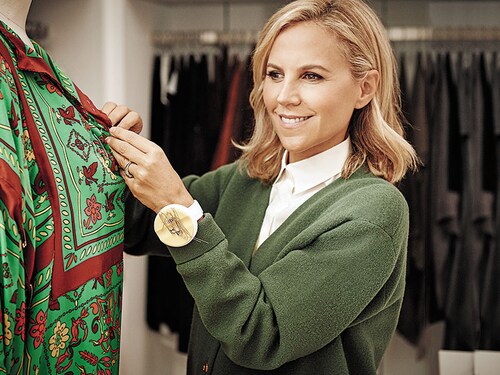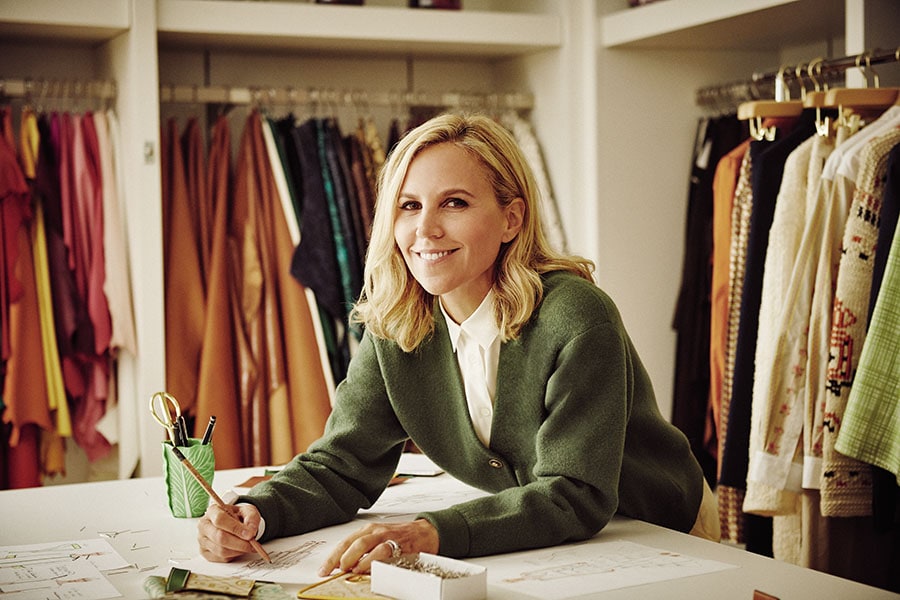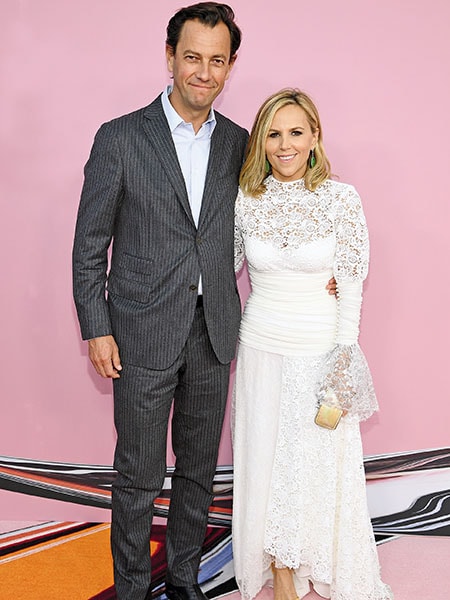Tory Burch's survival sketchbook
Amid a luxury fashion apocalypse, one of the century's greatest entrepreneurial retailers—and one of America's richest self-made women—brought us deep inside the battle to save her brand


After seven long days and sleepless nights in March, Tory Burch’s impeccably decorated library in her red-brick home in the Hamptons officially became a war room. Pierre-Yves Roussel, her husband and chief executive of her eponymous fashion company, claimed the patterned green couch. Across from him, Burch—the company chairman, clad in leggings—took the desk by the window overlooking their seven acres. The couple barely stepped outside the room for three weeks.
“One day went into the next, and one week went into the next,” says Burch, who left her Park Avenue apartment with a small suitcase on March 6, thinking a quarantine would not last long. “I don’t think we had a break for a solid month. It was a very scary time—2008 happened, and we saw our business change overnight. But this was nothing like 2008. This was much, much worse.”
Luxury fashion is fickle even in the best of times. The coronavirus has been an especially virulent pest. Stores around the globe shut down amid stay-at-home regulations. Chinese travellers—whose purchases account for some 30 percent of luxury-goods sales in Europe and North America—put away their travel bags. J Crew, Neiman Marcus and Brooks Brothers all filed for bankruptcy. Revenues at Gucci parent Kering and LVMH, Roussel’s former employer, fell around 40 percent in the second quarter. Ralph Lauren sales tumbled by two-thirds.
Burch and Roussel realised quickly how dire the situation was. Within weeks, they were closing many of their 315 Tory Burch stores across the globe, furloughing most of their retail employees and shelving expansion plans, and coping with a longtime employee’s death from Covid-19. They then began formulating new plans to make sure Tory Burch LLC didn’t unravel.
Throughout this disruptive moment for the world, for business and for retail, Burch and Roussel let Forbes ride along on their eight-month navigation of this apocalypse. They’ve had to improvise, shutting stores, rerouting supplies and revamping ecommerce efforts, all in the hope that the business, which generated almost $1.5 billion in revenue in 2019, with a profit margin Forbes estimated at 11 percent, could survive. “We didn’t know how we would be able to pivot and be agile,” Burch says. “The unknown was so difficult.”
But jumping into the unknown also offers lessons, both good and bad, on how to pilot through a monsoon, at a time when shoppers are wary of leaving home and the threat of deadly disease lurks in every public space.
Burch had a fairy-tale childhood growing up in a grand old home in Valley Forge, Pennsylvania, the daughter of a former actress and a financier, both of whom prized dressing well. Upon graduating from the University of Pennsylvania in 1988 with a degree in art history, Burch moved to New York with a passion for fashion. She worked for Zoran, a Yugoslavian designer who was her mother’s favourite, then had public-relations and editorial stints at Harper’s Bazaar, Ralph Lauren and Vera Wang. After she married investor Chris Burch in 1996, the couple built a portfolio of investments that not only helped them financially but also gained them a spot in New York high society.
The first Tory Burch boutique opened in February 2004 in Manhattan’s Nolita neighbourhood, run by the couple and based on her idea for an affordable luxury and lifestyle brand. In 2005, the day after she appeared on Oprah Winfrey’s show, the Tory Burch website got 8 million hits. Retail riches followed: That year, the brand hit $17 million in revenue. Two years later it grew to $113 million, its gold T logo inching its way onto the exclusive global list of luxury badges.

“Covid-19 has been a huge learning curve, but it’s been almost a reinvention and a reset as well,” Burch says. “We often say... never waste a good crisis.”
Then came troubles at home. In 2006, Burch initiated the end of her marriage the divorce was finalised two years later. Legal trouble arrived in 2012, when Chris started his own fashion company, C Wonder, which Burch claimed was informed too much by the premise of the brand they had launched together. They settled in early 2013, when Tory Burch LLC had $800 million in sales and 54 stores—and Forbes first declared her a billionaire. Chris stepped down as a director and sold most of his 28 percent stake to new minority investors General Atlantic and BDT Capital for $650 million. Burch describes her very public divorce as one of the toughest periods in her life.
The next year she began dating Roussel, who as chief executive of LVMH’s fashion group oversaw global brands such as Céline, Givenchy, Kenzo and Marc Jacobs, and was a special advisor to LVMH’s billionaire founder, Bernard Arnault. Burch had met Roussel in 2012, when LVMH briefly expressed interest in investing in her company. For about four years, Roussel split his time between New York and Paris. The couple wed in December 2018 at Burch’s home in Antigua, a renovated estate that once belonged to heiress, horticulturist and fashion icon Bunny Mellon. “We got married, we wanted to live together and wanted to be in the same country,” Burch says. So she approached Roussel with a plan: What if he became the next CEO of Tory Burch? It took a bit of convincing, but he agreed. “Even before the pandemic, working together was a question mark,” Roussel says. “Obviously, I come from a different world, different culture, different continent.”
“I know [Roussel] was very hesitant at the beginning,” says Vogue editor-in-chief Anna Wintour, who over the years built a close relationship with Roussel through his work in the industry. “Working with your wife could be a little bit challenging at times, so he took a little time to be persuaded.” Less than two weeks after their wedding, Burch announced Roussel as the new CEO of her company he officially started in January 2019, and she took a more creative role as executive chairman. The new partnership would soon be put to the test.

“Having Roussel during this crisis was a godsend for me and for our company,” Burch says of her husband
The Covid-19 crisis arrived amid a career high. Burch, 54, says her 16-year-old business, with stores in 35 countries, had its best month ever in January. Soon after, she decided not to do to a runway show at the September 2020 New York Fashion Week—an endeavour that costs millions of dollars and that some in the industry believe to be a waste of money. Instead, she planned to throw a big block party on Mercer Street in Manhattan, where she would be opening a new boutique.
On January 28, McDonald’s and Starbucks closed some locations in China that same day, Tory Burch LLC began shuttering its 29 stores in mainland China, including the 9,600-square-foot store in Shanghai, its largest in the world. Soon after, shutdown-related delays in Asia and Europe began to interrupt manufacturing of some Tory Burch products.
The first shock hit her supply chain. “You have one thing that comes from Italy, and it’s a button, and then Italy is closed,” Burch explains. “So that button on that sweater prevents the whole piece from being able to get made.”
When certain items couldn’t come together due to production delays, her team either changed their design or got rid of them entirely. Among the casualties: Two embroidered dresses from India and Eastern Europe and shoes from Italy. In some cases, they reused and repurposed fabrics in inventory from previous seasons, and moved production from places hit early by Covid-19, such as Europe and Asia, to Brazil.
Quality problems soon emerged. “Some of the products that we got as samples we were not so happy with,” Roussel says. So again, they either killed items or redesigned around the remaining parts. At one point, Burch cancelled an entire jewellery collection from Brazil that had run into production problems and didn’t meet her approval.
Next up: Moving inventory to wherever it would sell. After analysing real-time data and evaluating where stores were reopening and where consumer appetite was strongest, Roussel had items shipped from the rest of Asia to China, from Europe to the US, and from some US retail stores to the company’s online distribution centre in Atlanta. Roussel says he reduced orders of seasonal products and focussed on year-round favourites such as bags and sneakers.
Salvaging the product was just the first step. Figuring out where to sell proved equally vexing. As the world locked down, Burch’s huge physical footprint meant it was bleeding cash. By mid-March, Burch and Roussel had shut more than half of Burch’s 315 stores, including some of the 38 in greater China, 111 in the US, six in Canada and 13 in Europe. (It had begun reopening some stores in China in late February.) The company then furloughed most US sales staff and the majority of its retail personnel in Europe—it won’t say how many of its 5,000 employees worldwide overall—while continuing to pay for health insurance for US workers. “If you’re not able to protect what you have built,” says Burch of those decisions, “it becomes, obviously, a very hard, emotional journey.”
As with millions of entrepreneurs who saw their business upended, the balance between emotion and the need for cold logic amid the maelstrom proved a constant tension. Roussel had built an entire growth strategy around Asia, with at least 20 new stores planned in China through 2022. As spring turned to summer, the executive duo tried mightily to hold on to the plan, deferring as many openings as possible toward the end of their time frame, with just two stores opened this year and two more slated for December. “No one’s prepared for having all the stores closed and not knowing when they’ll reopen,” Roussel says. “I think it’s the ultimate test for a company.”
Similar streamlining followed with product selection for the 2021 line, which will be 20 percent smaller (Burch says a culling was already in motion before the pandemic). Going forward, collections will include more shoes (the Tory Charm loafer and Tory sneakers are this fall’s top sellers) and bags, items shoppers consider to be longer-term buys, or “investments” less likely to go out of style. The product mix won’t change much otherwise, a spokesperson says, pointing out that it was already selling an array of casual, sporty and more dressy options.
While customers still mostly gravitate to the brand for its colourful sandals and tiny handbags, Tory Sport, the luxury sportswear collection it launched in 2015, has emerged as a bright spot. The company gave the line more prominent placement on its homepage, added a Loungewear Shop to the website and increased the frequency of emails about it. Online sales of Tory Sport have grown by “more than 30 percent” since the beginning of the pandemic, the company says.
To finish the new, smaller collection, Burch had a truck deliver the partly completed dresses to her home in the Hamptons, and shifted her office from the library to the more spacious dining room. Out went the rugs and the furniture, replaced by glossy fabric samples and clothing racks. The lithe fashion icon fitted her new designs on two employees who, she says, were “a little more fit-model appropriate” than she is.
Compared to the world she knew just a few months earlier, it was a surreal, wrenching process, made worse when a friend and co-worker of 14 years succumbed to Covid-19 (Burch wouldn’t share any more details, citing her friend’s privacy). “It was awful,” she says. “It was very hard, and it still is, and it will be for a very long time.”
The pandemic has proven to be one of greatest accelerants in business history. As retailers—big-box stores and mom-and-pop shops alike—are forced to reinvent themselves on the fly, the winners have figured out how to implement ecommerce strategies today that were perhaps on the drawing board for five years down the road.
So too at Tory Burch. Shifting focus from physical stores, Roussel repurposed much of that spending toward ecommerce infrastructure and online campaigns, beginning in China, the Middle East and Japan. Pre-pandemic, especially within Japan’s $31 billion luxury market, online purchases were largely a non-factor. Luxury customers wanted to see, to touch, to smell their indulgent purchases before throwing down the credit card.
As the coronavirus caused habits to shift, Roussel began selling some items on Tmall, Alibaba’s retail site. In lockstep, he revamped and expanded Burch’s global website network. In June, he launched sites in Arabic and English serving Kuwait, Saudi Arabia and the United Arab Emirates. There were ongoing improvements and adjustments, as well as new hires in July and August. All Tory Burch sites, which now number 12, were optimised for mobile while incorporating artificial intelligence to generate personalised product recommendations.
Burch also introduced virtual styling, which enables customers to make private video appointments to see different items in the store. Top clients get even higher touch. In late August, Burch—who has been actively engaging with Tory Burch fans on Instagram (she asks them to send her direct messages with ideas)—joined 35 customers on a Zoom call and chatted with them about why they love the brand. The company is offering more private appointments, even outside normal business hours, and a styling concierge service that sends buyers a personal package of items to try on at home.
These moves couldn’t come fast enough. As lockdowns began to be lifted around the world, Burch and Roussel started reopening stores, bringing back most, but not all, furloughed employees. By early June, almost all 315 outlets were back—but customers weren’t. Foot traffic remains down 45 percent, Burch says. On a recent Saturday afternoon at the Tory Burch store in Manhattan’s Meatpacking District, at what one employee said was the busiest hour of the day, a grand total of three customers were perusing $225 Tory sneakers and new $700 Eleanor bags. When customers do show up, however, Burch says they are younger and more likely to make a purchase than the average pre-Covid customer.
“I’ve been working pretty severe hours for the last 15 years to build a company and do it in a way that really thinks about the long term,” Burch says. “We wanted to be strong, have grace under pressure, pivot and do what we could to salvage our business, and we did.”
It helped that she had been disciplined in the past. “[Burch] was very cost-conscious,” recalls Brigitte Kleine, president of Tory Burch from 2005 to 2016. “When you start out that way and keep that as part of your culture, it pays dividends—literally and figuratively.”
The numbers offer some hope. Data from Second Measure, a company that analyses anonymised credit-card transactions from retail stores and online, reveal how dire things were in the spring, with Tory Burch’s direct US sales down by 67 percent in April year-over-year, and then 41 percent in May. But those same figures also indicate that Burch and Roussel weathered the storm: In August, the year-over-year drop was just 4 percent. (A spokesperson for Tory Burch LLC says the Second Measure numbers are directionally correct but don’t include purchases using cash, PayPal or Apple Pay.) Overall, Burch and Roussel predict that Tory Burch revenue will fall by roughly 20 percent this year, to around $1.2 billion. “Certainly, we’re not where we were,” Burch admits.
Tellingly, neither will say whether Tory Burch is still profitable—or how much of a loss it has incurred. According to Roussel, the company carries “reasonable debt”. The sales reduction, along with lesser valuations among publicly traded competitors, has lowered Forbes’s estimated value of Burch’s 28.3 percent stake to $500 million, down from $800 million in 2019. We estimate that Burch, who has roughly a quarter-billion dollars in other assets, including cash and real estate, is worth $750 million, good for No 26 on Forbes’s list of America’s Richest Self-Made Women. Forbes deemed Burch a billionaire from 2013 through 2015, before she fell from the ranks as valuations of publicly traded fashion brands dropped.
But she’s still in business, and the moves she and Roussel have made augur well for the long term. Roussel says the company is more prepared for future shutdowns and will continue to adapt its supply chain as necessary. While the pandemic has accelerated broader trends toward casual apparel, Burch says she still sees women wanting to dress up and experience joy in tough times. Adds Roussel: “We have iconic investment products, products that are timeless. You buy it, you know you can wear it anytime. [That] is how you get out of the crisis.” To underscore it, Roussel and Burch are expanding their footprint again, with plans to open three new stores in Canada as well as one in Australia and two in China before the end of the year. In early 2021, the company will launch a website for customers in China, and do the same for Hong Kong, Singapore, Australia and Brazil in the second half of next year.
“Would you buy into Goldman Sachs on the eve of the financial crisis in 2008 or 2009? The answer would be no, probably not, if you had a crystal ball,” says Byron Trott, founder of investment and advisory firm BDT Capital Partners, a minority shareholder. “But going through the pandemic, going through the cycles that have occurred in the last eight years of our investment, Tory’s business has been really resilient from a financial perspective.”
That resilience, though, now comes paired with battle-hardened perspective. “If the crisis had lasted longer, with all our stores closed, it would have been a different story, obviously,” Roussel says. “We’re still in the middle of it, and who knows what’s around the corner.”
First Published: Jan 16, 2021, 09:00
Subscribe Now